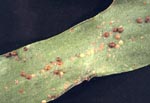|
Description
The Black Scale is dark brown or black, oval, and convex.
It is easily recognized by a raised H-shaped on its dorsal (upper
surface) and somewhat roughened appearance.
Hemispherical
Scales appear smooth, strongly convex, shiny, brown, and roughly
circular in outline. Immature stages (crawlers) are white and have
the typical "H" shaped pattern typical of the above mentioned
black scale.
|
The
Soft Brown Scale is oval and more flattened than either
the black or hemispherical scales: It is a pale brown, dirty
white or grayish mottled with dark brown on the back. The
shell is pliable. An additional species, the long or elongate
soft scale is similar in appearance, but more elongate.
|
Click on image for larger
version

Figure 1. Brown Soft Scale on Citrus
|
|
Click
on image for larger version

Figure 2. Brown Soft Scale on Staghorn Fern
|
The
Nigra Scale varies in size, shape and color depending
on its host. It may appear slim and elongate when found on
thin stems or petioles or oval when on leaf blades. Its outer
shell is hard and shiny black or dark brown. Adult male scales
are usually rare, tiny, and either winged or wingless. They
only live long enough mate with the females and then die.
|
Life
History
Scales are similar in habit to mealybugs in that they feed on plant
sap. They are usually found on the undersides of the leaves and
stems, but may be found on the upper leaf surface on some hosts.
Generally older and younger leaves may be attacked, but scales on
stems usually prefer the new succulent growth. Out-of-doors scales
only produce 1 - 2 generations per year, but under greenhouse conditions
they may have 3 - 6 generations per year often with overlapping
between successive generations. Generally,' the female scale will
lay as many as 2,000 eggs beneath her outer shell. With the soft
brown scale, only 1 or 2 live young are born at a time over a period
of several months. Young crawlers, similar to mealybugs, emerge
after several days or weeks and migrate over the host plant looking
for a feeding site. Soft brown and hemispherical scale crawlers
are sluggish and only move a short distance from the female. Scale
crawlers progress through 3 growth stages before changing into adults.
Scale crawlers are usually paler in color and flatter than the adult
female. Following egg laying, the female dies. Most scale species
prefer humid and warm conditions with shade. Extremes in temperature
appear to be detrimental. A scale generation occurs about every
2 months under greenhouse conditions.
|
SCALE
SPECIES
|
HOSTS
|
| Black
Scale |
Weeping
Fig, Citrus, Banana, Olive |
| Hemispherical
Scale |
Ferns,
Schefflera, Asparagus Fern, non-woody evergreens |
| Soft
Brown Scale |
Schefflera,
Weeping Fig, Ferns, Citrus |
| Nigra
Scale |
Weeping
Fig, Citrus, Ivy, Holly |
Damage
Feeding by soft scales is similar to mealybugs resulting in a distorting,
stunting, and yellowing of the foliage. Honeydew is also produced
allowing for sooty mold development.
Nonchemical
Control
Pruning out of heavily infested plant parts, use of predators, such
as the green lacewing, and parasitic wasps can be effective.
Chemical
Control
Insecticidal sprays for control of crawlers may be applied.
|

